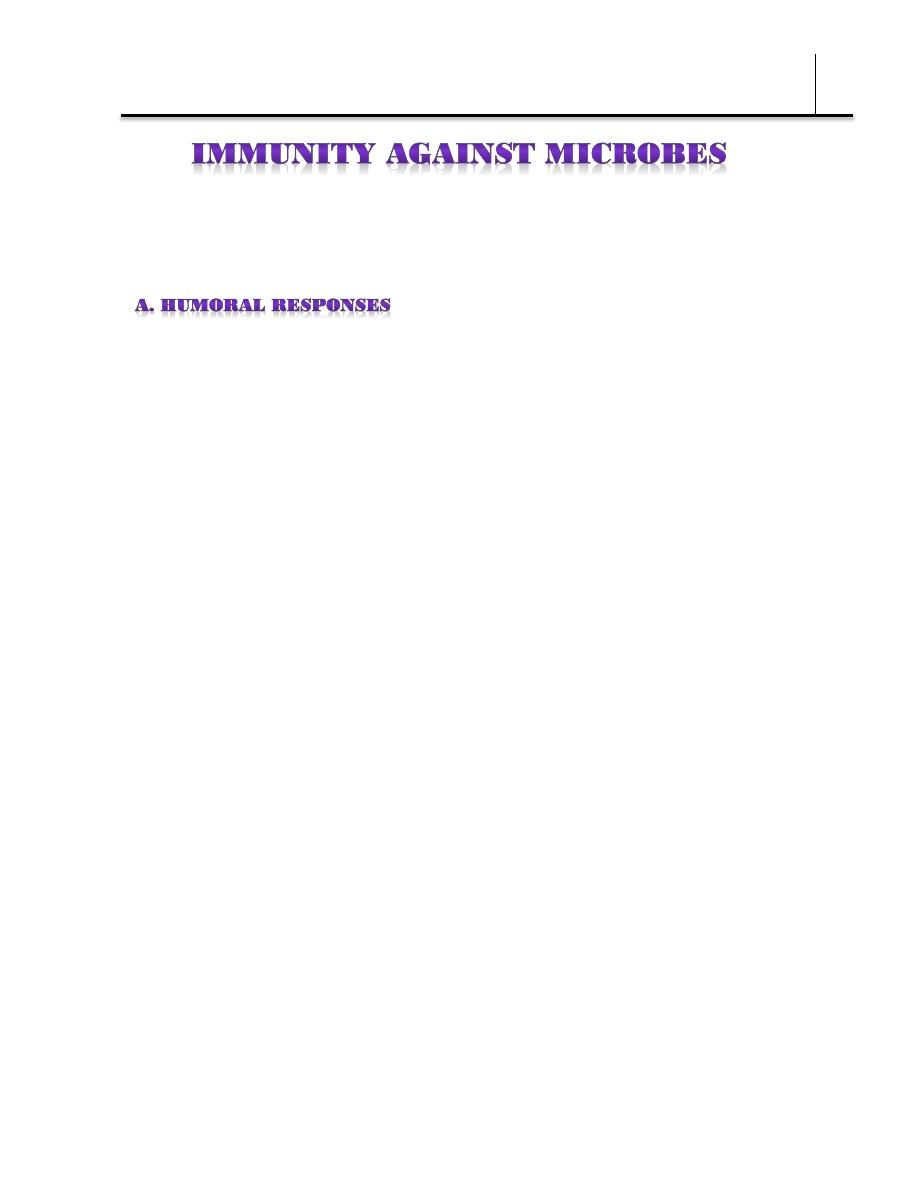
Immunology
Dr. Donya A Makki Immunity to microbes
1
The innate and adaptive immune systems provide protection against
an array of infectious organisms that vary in size, method of entry,
reproduction and pathologies.
The innate humoral responses are preexisting and begin acting
against infectious agents upon initial contact.
Activation of the complement system (alternative or mannan
binding pathway):
1. Direct lysis of microbial cells via assembly of the membrane attack
complex
2. C3b and C4b act as opsonins to accelerate the phagocytic
ingestion and destruction of microbes
3. C3a, C4a, and C5a help to initiate inflammation by attracting and
activating leukocytes.
Antibodies (adaptive immune response):
1. enhance the role of complement by initiating the classical
pathway.
2. tag infectious agents for destruction by phagocytes (opsonization)
or by natural killer cells and eosinophils (antibody-dependent cell-
mediated cytotoxicity).
3. lgE can trigger the release of inflammatory mediators by mast
cells and basophils, an important element in immunologic resistance
to parasitic worms.
4. inhibit entry of microbes into the body and into cells by
neutralization.

Immunology
Dr. Donya A Makki Immunity to microbes
2
Many infectious agents enter host cells. Some may be taken up by
phagocytes using toll-like receptors or Fc receptors and complement
receptors. Once inside, they are sheltered from the actions of
antibodies and complement, so cell-mediated responses are required
to clear the infection. Within cells, viruses persist and reproduce in
the cytosol (The cytosol or intracellular fluid (ICF) or cytoplasmic
matrix is the liquid found inside cells). Most intracellular bacteria live
within endosomes (endosomes: Small membrane-bound vesicles
inside the cell, when they are separated, they might fuse with
lysosomes) formed during their entry into the cells. The cytosolic and
endosomal compartment, however, are not completely isolated from
one another. Extracellular viruses (and cellular debris containing viral
particles) can be taken up by endosomes via phagocytosis. In
addition, some intracellular bacteria can exit endosomes and enter the
cytosol, as can some of their products or fragments.
Infectious organisms or products in the cytosol will be processed and
presented on MHC class I molecules, eliciting responses by CD8+ T
cells.
Infectious organisms and fragments present in endosomes
(phagolysosomes) will be processed there and presented by MHC
class II molecules, generating CD4 + T cell responses.
The cytotoxic T-cell responses (CD8 +) and delayed-type
hypersensitivity (CD4+) responses that are generated are then
capable of destroying the infected cells, disrupting the reproduction of
the invasive organisms, and destroying the remaining microbes.
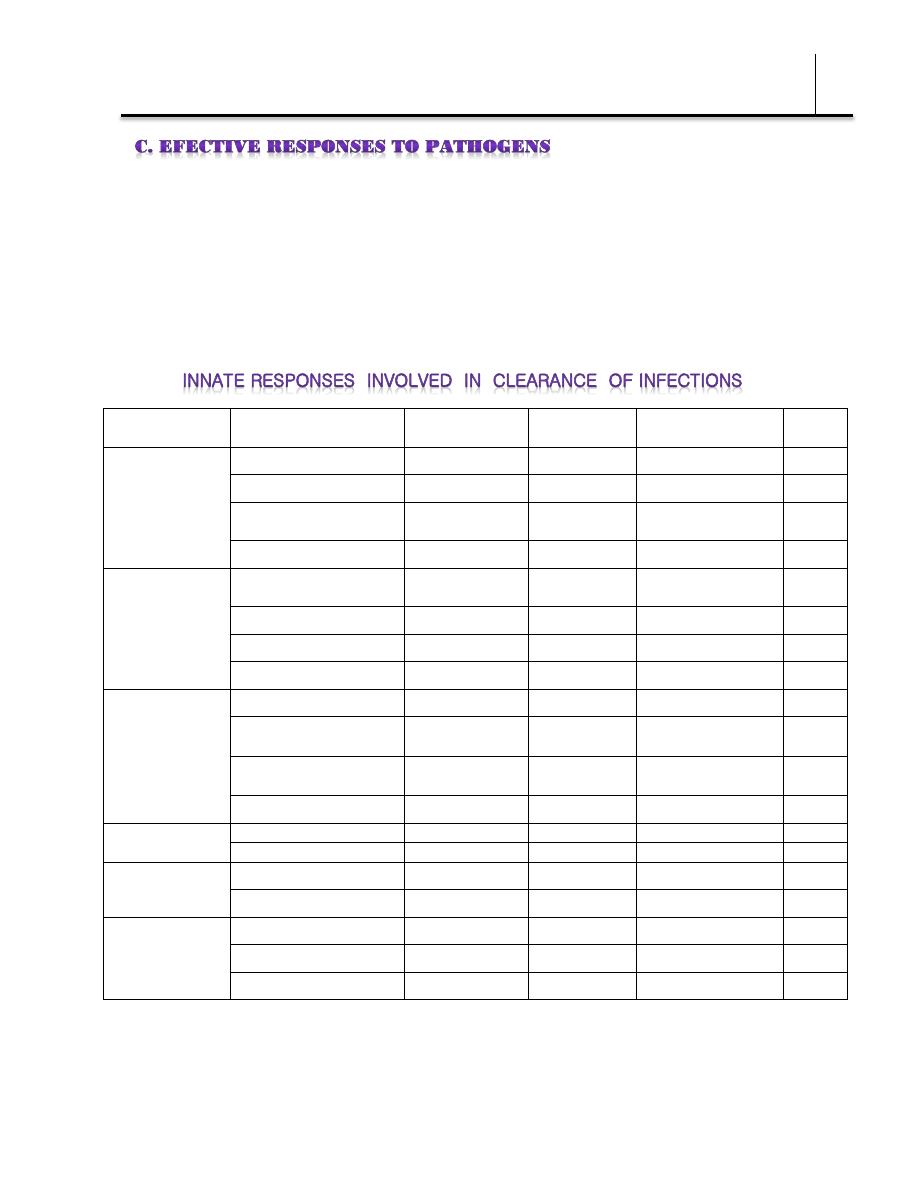
Immunology
Dr. Donya A Makki Immunity to microbes
3
Infectious organisms are specialized to fight and take advantage of
specific positions in the host environment, intracellular or extracellular.
The host immune system, in turn, must be versatile enough to detect,
contain, and attack the invasive organisms. The types of immune
responses that will be most effective are determined by the nature of
the infectious agents (Tables 1 and 2).
Organisms
Name
Phagocytosis
Neutrophils
Complement
NK
cells
Viruses
(intracellular,
cytoplasmic)
Influenza virus
Mumps virus
Morbillivirus
( measles,
rubeola)
Rhinovirus
Bacteria
(intracellular)
Listeria
monocytogenes
Legionella spp.
Mycobacteria
Rickettsia
Bacteria
(extracellular)
Staphylococcus spp.
Streptococcus spp.
reduced effectiveness
because of bacterial
capsules
reduced effectiveness
because of bacterial capsules
Neisseria spp.
reduced effectiveness
because of bacterial
capsules
reduced effectiveness
because of bacterial capsules
Salmonella typhi
Protozoa
(intracellular)
Plasmodium malariae
L. donovani
Protozoa
(extracellular)
Entamoeba histolytica
Giardia Iamblia
Fungi
(extracellular)
Candida spp.
Histoplasma
Cyptococcus

Immunology
Dr. Donya A Makki Immunity to microbes
4
IgM , IgG , IgA
Complement
activation
Opsonization ADCC Neutralizing
antibody
IgE CTL DTH
Viruses
Bacteria
(intracellular)
Bacteria
(extracellular)
Protozoa
(intracellular)
Protozoa
(extracellular)
Fungi
Flatworms
Roundworms
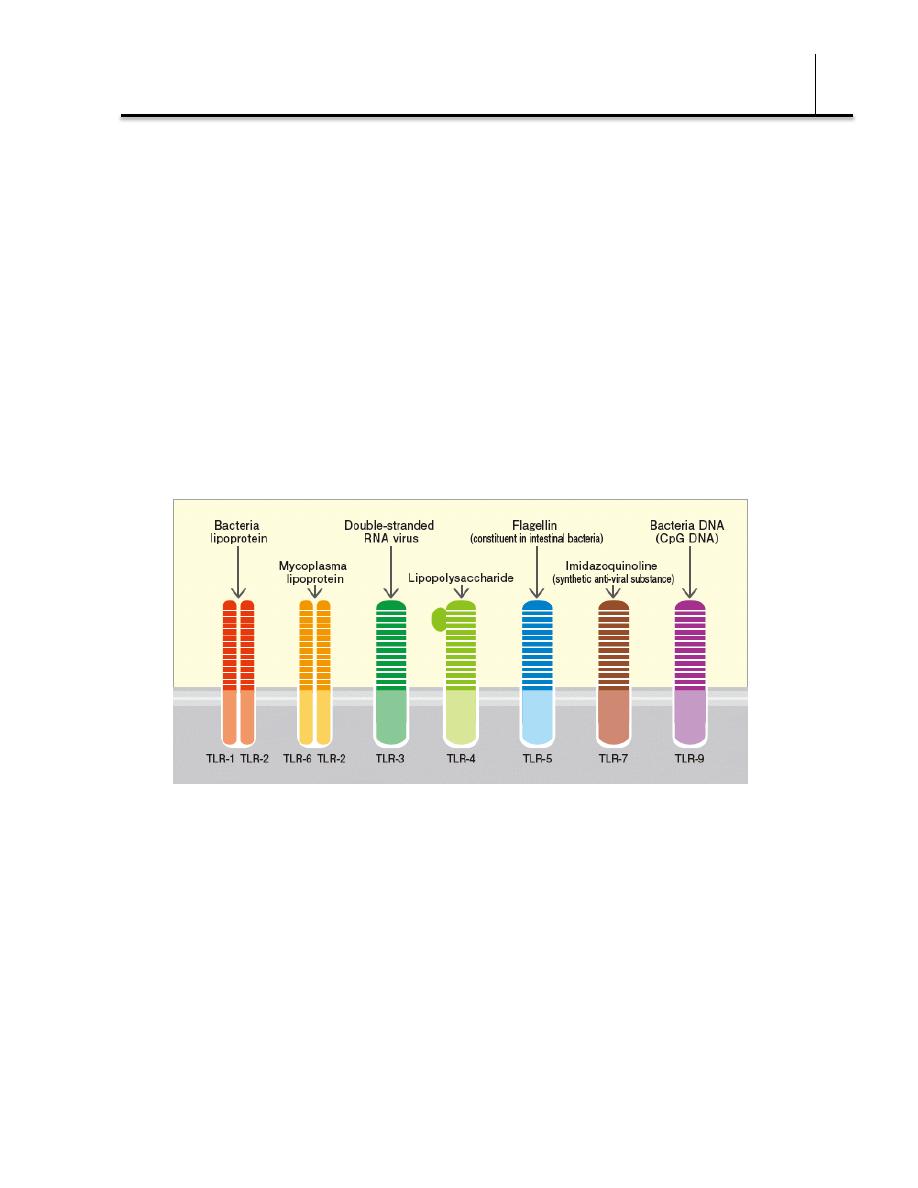
Immunology
Dr. Donya A Makki Immunity to microbes
5
Note regarding some receptors mentioned
Mannose receptor: aid in bacterial infection ex: the mannose
receptor helps Mycobacterium tuberculosis to infect and grow in
macrophages, preventing formation of the phagolysosome to avoid
degradation.
Toll-like receptors (TLRs) are receptors expressed in macrophages
and dendritic cells, that recognize structurally conserved molecules
derived from microbes. Once these microbes have breached physical
barriers such as the skin or intestinal tract mucosa, they are
recognized by TLRs, which activate immune cell responses. There are
13 TLRs each one has different function)
T-Cell Receptor (TCR) is a complex of integral membrane proteins
that participates in the activation of T-Cells. Stimulation of TCR is
triggered by MHC (Major Histocompatibility Complex) molecules on
Antigen Presenting Cells resulting in cellular proliferation,
differentiation, Cytokine production, and/or activation-induced cell
death.
Toll like receptors and mannose receptor are for innate immune
response, while TCR are for adaptive immune response.

Immunology
Dr. Donya A Makki Immunity to microbes
6
Immunity to bacterial infections is achieved by means of antibody
unless the bacterium is capable of intracellular growth, in which case
delayed- type hypersensitivity has an important role (T cells find the
antigens and activate macrophages).
Bacteria enter the body either through a number of natural routes
(e.g., the respiratory, gastrointestinal, and genitourinary tracts) or
through normally inaccessible routes opened up by breaks in mucous
membranes or skin. Depending on the number of organisms entering
and their virulence, different levels of host defense are enlisted. If the
inoculum size and the virulence are both low, then localized tissue
phagocytes may be able to eliminate the bacteria via nonspecific
innate defenses. Larger inocula or organisms with greater virulence
tend to induce antigen-specific adaptive immune responses.
In some bacterial infections, disease symptoms are caused by the
immune response instead of the pathogen itself. Pathogen-stimulated
overproduction of cytokines leads to the symptoms associated with
bacterial septic shock, food poisoning, and toxic shock syndrome. For
instance, cell wall endotoxins of some gram negative bacteria activate
macrophages, resulting in release of high levels of IL-1 and TNF, which
can cause septic shock. In staphylococcal food poisoning and toxic
shock syndrome, exotoxins produced by the pathogens function as
superantigens which activates T cells resulting in systemic production
of cytokines causing many of the symptoms of these diseases.
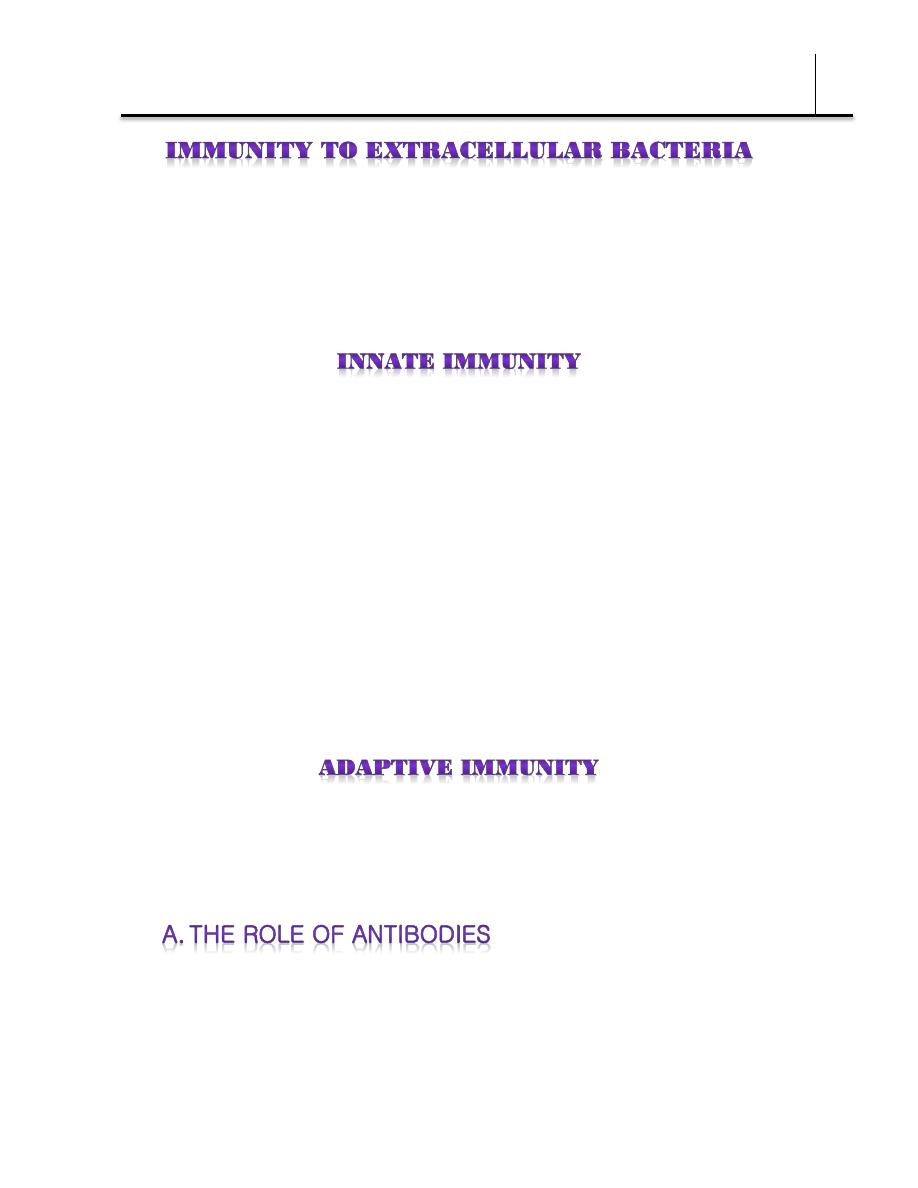
Immunology
Dr. Donya A Makki Immunity to microbes
7
Extracellular bacteria (ex: Staphylococcus, Streptococcus, Neisseria,
Bordetella, and Yersinia) can be pathogenic, because they induce
localized inflammatory response or because they produce toxins.
Complement, antibodies, and phagocytes will be directed against
infections by extracellular bacteria.
Innate immunity to extracellular bacteria is achieved by:
1. Complement activation:
Complement products are directed against peptidoglycan of Gram-
positive bacteria, LPS of Gram-negative bacteria, and mannose.
2. Activation of phagocytes:
Through mannose receptor, scavenger receptor, Fc receptors,
complement receptors
3. Inflammation:
Cytokines induce leukocytes infiltration to ingest and destroy
bacteria
Adaptive immune responses to extracellular bacteria and their toxins
consist of antibody production and the activation of CD4+ helper T
cells.
Antibodies neutralize and eliminate microbes and toxins by several
mechanisms.
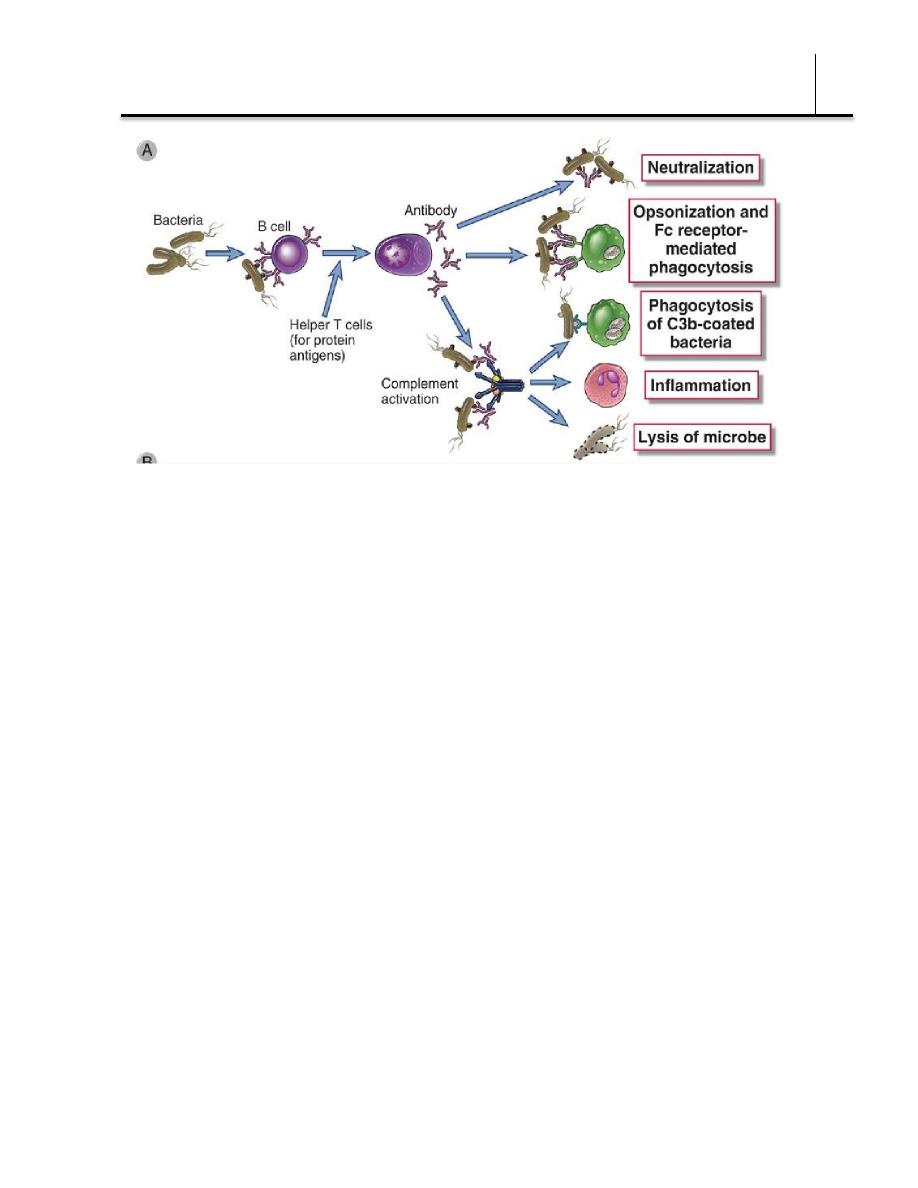
Immunology
Dr. Donya A Makki Immunity to microbes
8
Antibodies that binds to accessible antigens on the surface of a
bacterium can, together with the C3b component of complement, act
as an opsonin that increases phagocytosis and thus clearance of the
bacterium. In the case of some bacteria—notably, the gram-negative
organisms—complement activation can lead directly to lysis of the
organism. Antibody-mediated activation of the complement system
can also induce localized production of immune effector molecules that
help to develop an amplified and more effective inflammatory
response. For example, the complement fragments C3a and C5a act as
anaphylatoxins, inducing local mast-cell degranulation and thus
vasodilation and the extravasation of lymphocytes and neutrophils
from the blood into tissue spaces. Other complement split products
serve as chemotactic factors for neutrophils and macrophages, thereby
contributing to the buildup of phagocytic cells at the site of infection.
Antibody to a bacterial toxin may bind to the toxin and neutralize it;
the antibody-toxin complexes are then cleared by phagocytic cells in
the same manner as any other antigen-antibody complex.
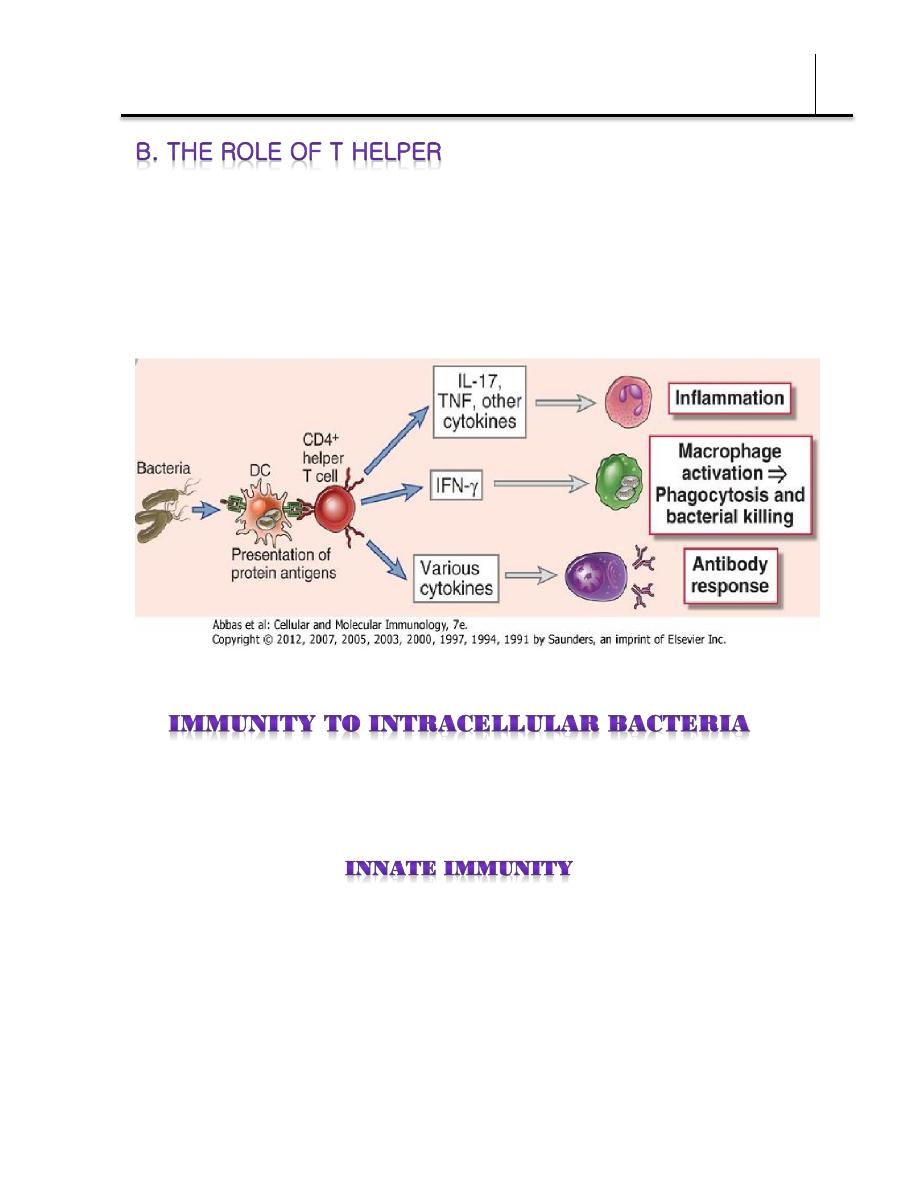
Immunology
Dr. Donya A Makki Immunity to microbes
9
Helper T cells produce cytokines that stimulate B cell for antibody
production, T helper produces also interferon gamma, by that
activating macrophages occur, and T cells cause inflammation by
various cytokines (IL 17, TNF, and other cytokines).
Both innate and adaptive immune systems interact to fight
intracellular bacterial infections. Examples of intracellular bacteria are
Mycobacteria, Shigella, Salmonella, Listeria, and Rickettsia.
Although innate immunity is not very effective against intracellular
bacterial pathogens, intracellular bacteria can activate NK cells, which
in turn provide an early defense against these organisms.
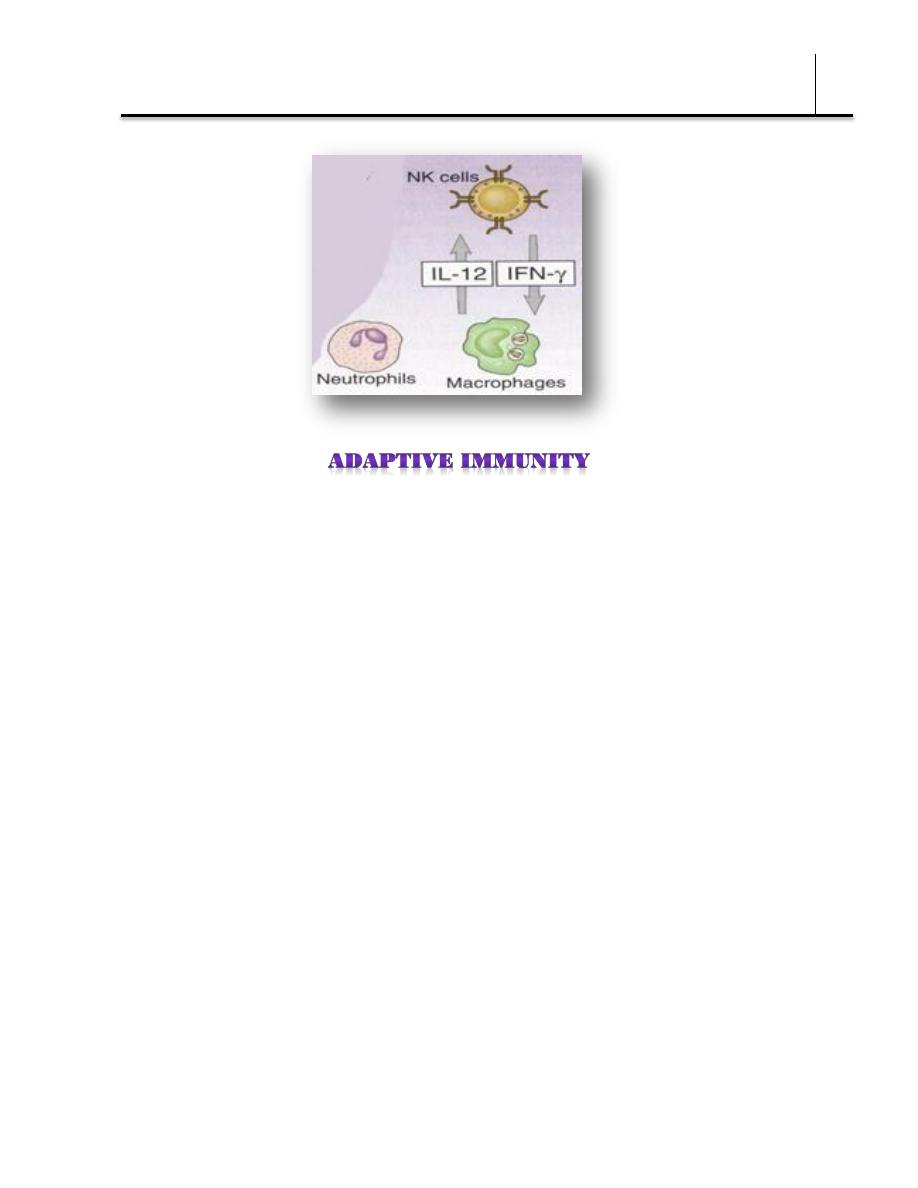
Immunology
Dr. Donya A Makki Immunity to microbes
10
The typical adaptive immune response to intracellular bacteria is cell-
mediated immunity, in which T cells activate phagocytes to eliminate
the microbe. In this response, cytokines secreted by CD4 T cells are
important—most notably IFN gamma, which activates macrophages to
kill ingested pathogens more effectively.
Innate immunity may control bacterial growth but elimination of
bacteria requires adaptive immunity.
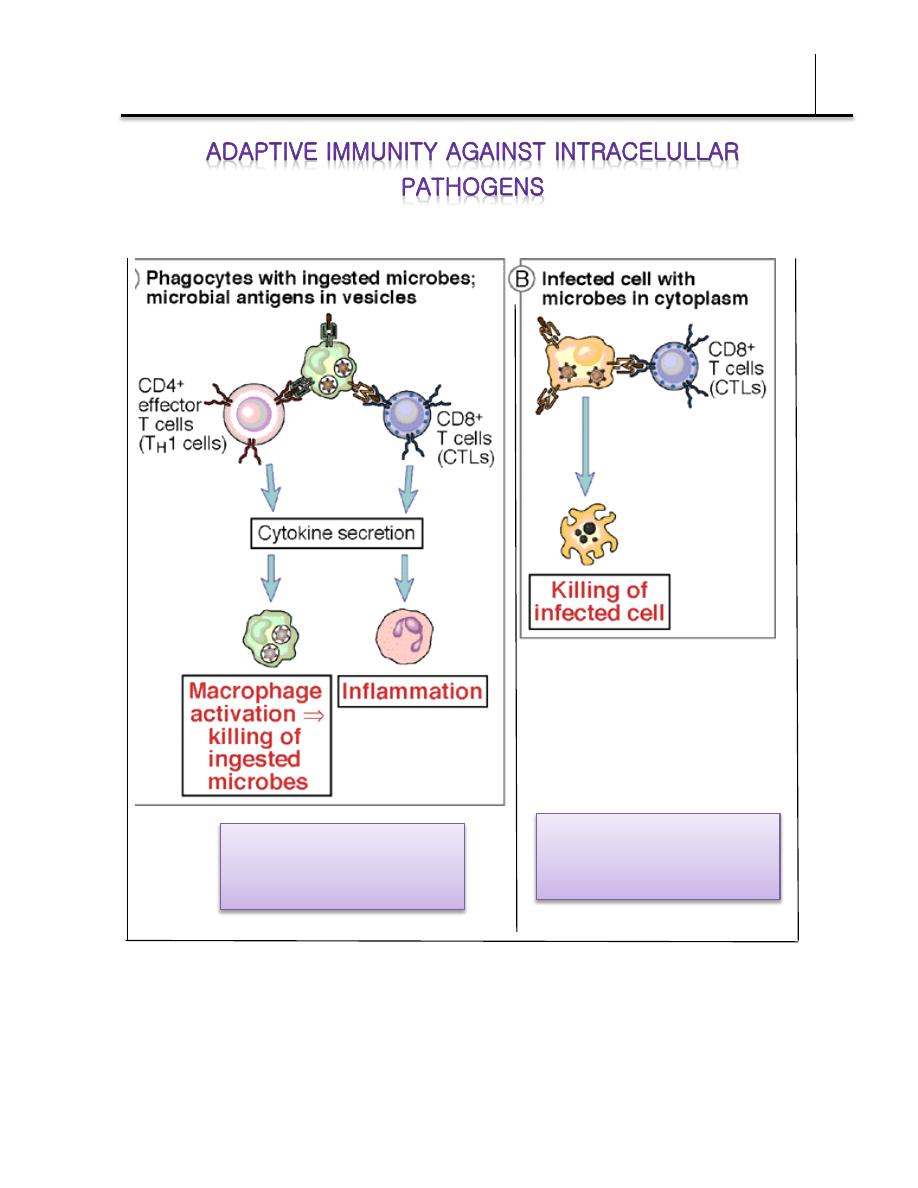
Immunology
Dr. Donya A Makki Immunity to microbes
11
Bacteria inside vesicles
of phagocytes
Bacteria in cytoplasm of
infected cell
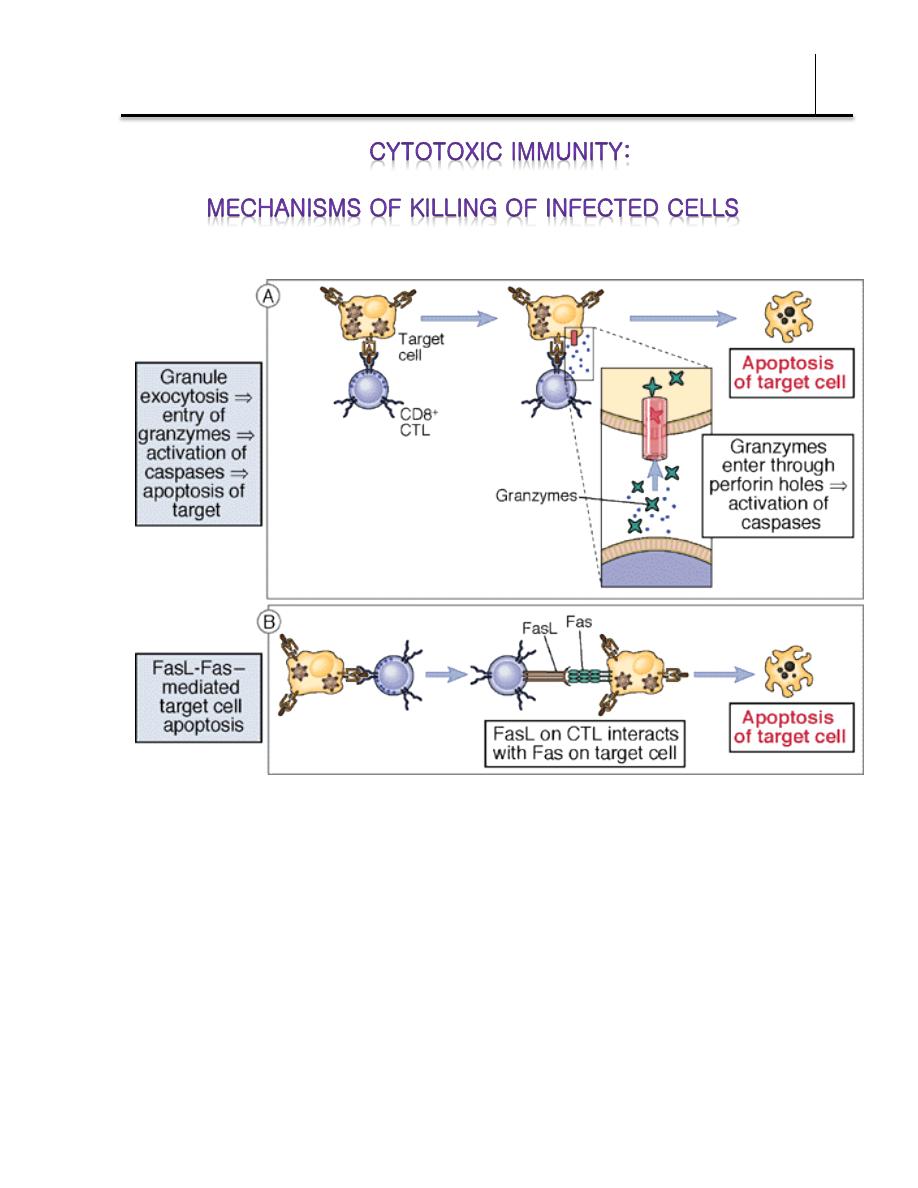
Immunology
Dr. Donya A Makki Immunity to microbes
12
Granzymes are proteases that function to induce apoptosis
(programmed cell death) of the target cells expressing MHC class I
within cytotoxic T cells and natural killer (NK) cells, by that eliminating
cells that have become cancerous or are infected with viruses or
bacteria. The granzymes also kill bacteria and inhibit viral replication.
In NK cells and T cells, the granzymes are packaged in cytotoxic
granules with perforin.
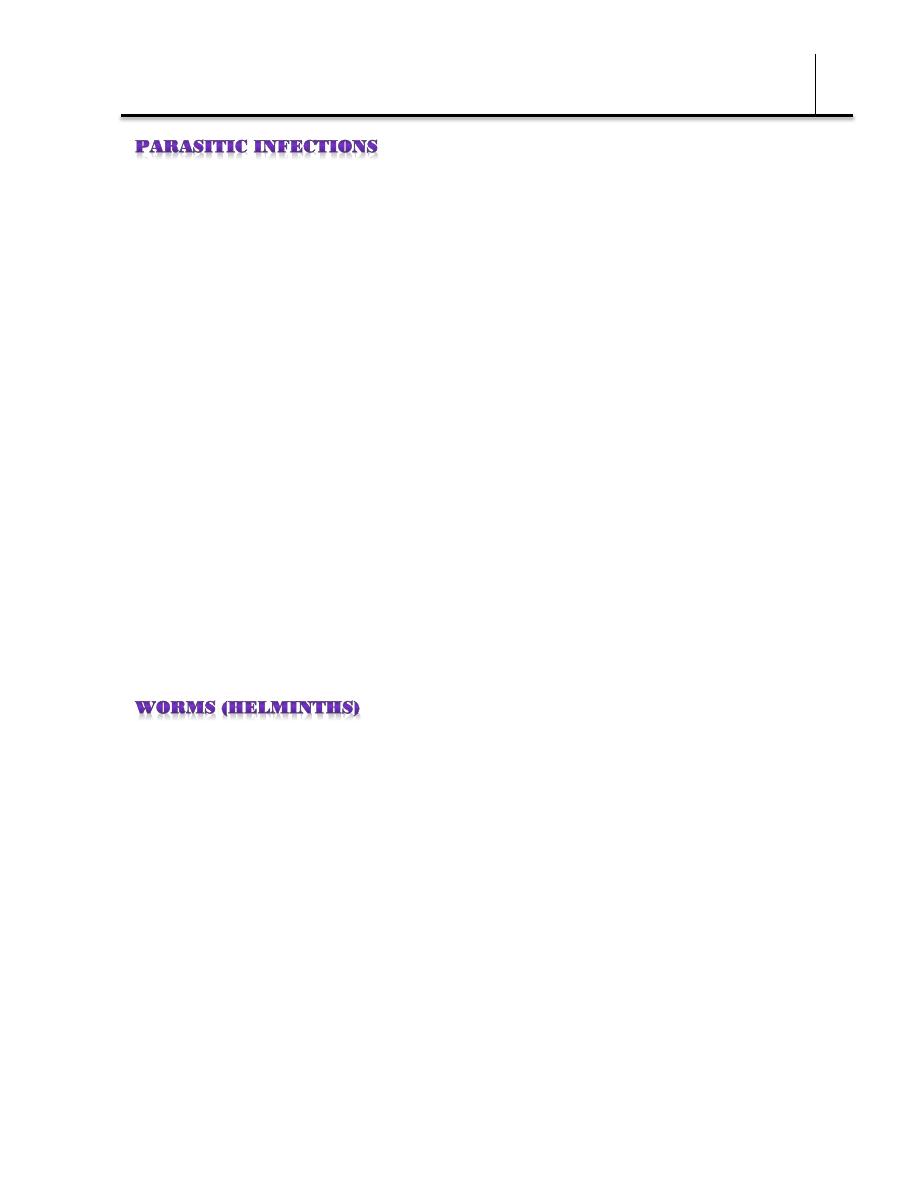
Immunology
Dr. Donya A Makki Immunity to microbes
13
The term parasite encompasses a vast number of protozoan and
helminthic organisms (worms). The diversity of the parasitic universe
makes it difficult to generalize, but a major difference between these
types of parasites is that the protozoans are unicellular eukaryotes
that usually live and multiply within host cells for at least part of their
life cycle, whereas helminths are multicellular organisms that can be
quite large and have the ability to live and reproduce outside their
human host.
Parasites can evade the immune system, allowing them to chronically
infect their human hosts.
Malaria, African sleeping sickness, Chagas’s disease, leishmaniasis,
and toxoplasmosis are among the most common parasitic diseases.
Resistance to leishmaniasis correlates well with the production of IFN-
gamma and the development of a T helper 1 response.
However, T helper2 response to Leishmania infection might occur,
producing high levels of IL-4.
Although helminths are exclusively extracellular and therefore more
accessible to the immune system than protozoans, most infected
individuals carry few parasites. Unlike protozoan parasites, helminths
do not multiply within their hosts. Thus, the immune response is not
strongly engaged, and the level of immunity generated can be very
poor. For Schistosoma, an immune response does develop, but it is
usually not sufficient to eliminate the adult worms. Instead, the
worms survive for up to 20 years, causing prolonged morbidity. Adult
schistosome worms have several unique mechanisms that protect
them from immune defenses. These include decreasing the expression
of antigens on their outer membrane and enclosing themselves in a

Immunology
Dr. Donya A Makki Immunity to microbes
14
glycolipid-and-glycoprotein coat derived from the host, masking the
presence of their own antigens. Among the antigens observed on the
adult worm are the host’s own ABO blood-group and histocompatibility
antigens. The immune response is, of course, diminished by this
covering made of the host’s self antigens.
The immune response to infection with S. mansoni is dominated by T
helper2 like mediators, with high titers of antischistosome IgE
antibodies, localized increases in degranulating mast cells, and an
influx of eosinophils.. These cells can then bind the antibody-coated
parasite using their Fc receptors for IgE or IgG, inducing degranulation
and death to the parasite via antibody- dependent cell-mediated
cytotoxicity (ADCC). However, immunization studies in mice suggest
that a T helper 1 response, characterized by IFN-gamma and
macrophage accumulation, may actually be more effective for inducing
protective immunity.

Immunology
Dr. Donya A Makki Immunity to microbes
15
References
Doan T and Roger Melvold R (2013) Immunology. Lippincott's Illustrated Reviews
Abbas et al (2012) Celluler and moleculer immunology. Immunity to infectious agents.
Elseiver.
http://physio.ucsf.edu/GEMS/courses/Immunology/materials/fa11_essential_immunology/august_30/immunity_to_infections_a
Murphy K. Immunity against infection. Janeway’s Immunobiology 8th Edition
http://imunologie.lf2.cuni.cz/en/soubory_vyuka/infection_immunity.ppt
Ulvestad E. Immunity to microbes
http://www.uib.no/Broegelmann/brsi/documents_files/page2_16.ppt
Ling P. Immunity to Pathogens
Protozoan and Helminth Parasites : Immune evasion.
http://www.ppdictionary.com/parasites_3.htm
Endosome
http://www.cellimagelibrary.org/browse/cellcomponent/Endosome
Immune response to infectious diseases.Ch17. The Immune System in
Health and Disease
http://wenku.baidu.com/view/5bc7b510a2161479171128fe.html
Parungao M . Bio 151 lecture 15 continued
http://www.slideshare.net/lhenparungao/bio-151-lecture-15-continued
Akira S. Could fruit fly immune receptors be relevant to humans?
http://www.jst.go.jp/EN/research/bt08_en.html
Nangola S. (2012) Immunity to Microbes: Bacteria, Virus, Fungi and Parasites
http://dc349.4shared.com/doc/alJ_mkA2/preview.html
T-Cell Receptor (TCR) Overview
http://www.lifetechnologies.com/iq/en/home/life-science/cell-analysis/signaling-pathways/t-cell-
receptor-tcr/t-cell-receptor-tcr-overview.html
Bots M, Medema JP (2006). "Granzymes at a glance". J. Cell. Sci. 119 (Pt 24): 5011–4.
Walch M, Dotiwala F, et al. (2014).
"Cytotoxic cells kill intracellular bacteria through granulysin-
mediated delivery of granzymes."
Peters, P. J. "Cytotoxic T Lymphocyte Granules Are Secretory Lysosomes, Containing Both Perforin and
Granzymes." Cytotoxic T Lymphocyte Granules Are Secretory Lysosomes, Containing Both Perforin and
Granzymes.
Rockefeller
University
Press,
1
May
1991.
Web.
10
Nov.
2013.
http://jem.rupress.org/content/173/5/1099.abstract
